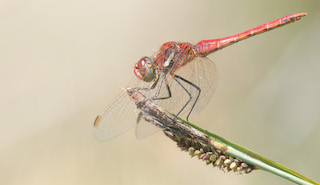 Windmill Farm is a good place to see Red-veined Darters, a relatively scarce summer migrant to the UK.
Windmill Farm is a good place to see Red-veined Darters, a relatively scarce summer migrant to the UK.
Photo: Dougy Wright
Scientific name: Sympetrum fonscolombii
Other common names: Nomad
Conservation status: IUCN Red List: Least Concern
What to look for:
- Colouring : Mature males have a bright red abdomen, while the female’s is brownish-yellow with two black lines along each side. The males and females have red- and yellow-veined wings, respectively. Immature males have a similar colouring to the female, but with only a single black line along each side of the abdomen.
- Size: A small-ish dragonfly, up to 4 cm in length and up to 6 cm wingspan.
- Where : This is a migrant species, mainly to the southwest of the UK (but with occasional records as far north as Scotland), from southern Europe, with a preference for shallow pools and still water.
- Similar species : It can be difficult to tell female Darter species apart: the website of the British Dragonfly Society has good species descriptions.
 The brightly coloured Red-veined Darter is a relatively scarce summer migrant to the UK, mainly to the milder southwest regions. Its main distribution is southern to central Europe, Africa and Asia, where it can be found on the wing throughout the year. In the late spring, newly emerged Red-veined Darters in the Mediterranean regions may migrate towards central Europe and even further northwards, and it is some of these we are most likely to see in Cornwall. Males and females from this generation mate, with a pair staying in tandem while eggs are oviposited in the water. A second generation emerges in later summer: egg and larval development is rapid in this dragonfly species (as little as three months).
The brightly coloured Red-veined Darter is a relatively scarce summer migrant to the UK, mainly to the milder southwest regions. Its main distribution is southern to central Europe, Africa and Asia, where it can be found on the wing throughout the year. In the late spring, newly emerged Red-veined Darters in the Mediterranean regions may migrate towards central Europe and even further northwards, and it is some of these we are most likely to see in Cornwall. Males and females from this generation mate, with a pair staying in tandem while eggs are oviposited in the water. A second generation emerges in later summer: egg and larval development is rapid in this dragonfly species (as little as three months).
Did you know…?
…Dragonflies do not go through a pupal stage in their development, unlike butterflies. The adult emerges from the final moult of the larval stage, which takes place above the waterbody surface.
…The Red-veined Darter has been expanding its global range northwards since the 1990s, possibly in response to climate change.
Published: June 2014 (updated May 2017)
Author: Amanda Scott
Photos: Dougy Wright
